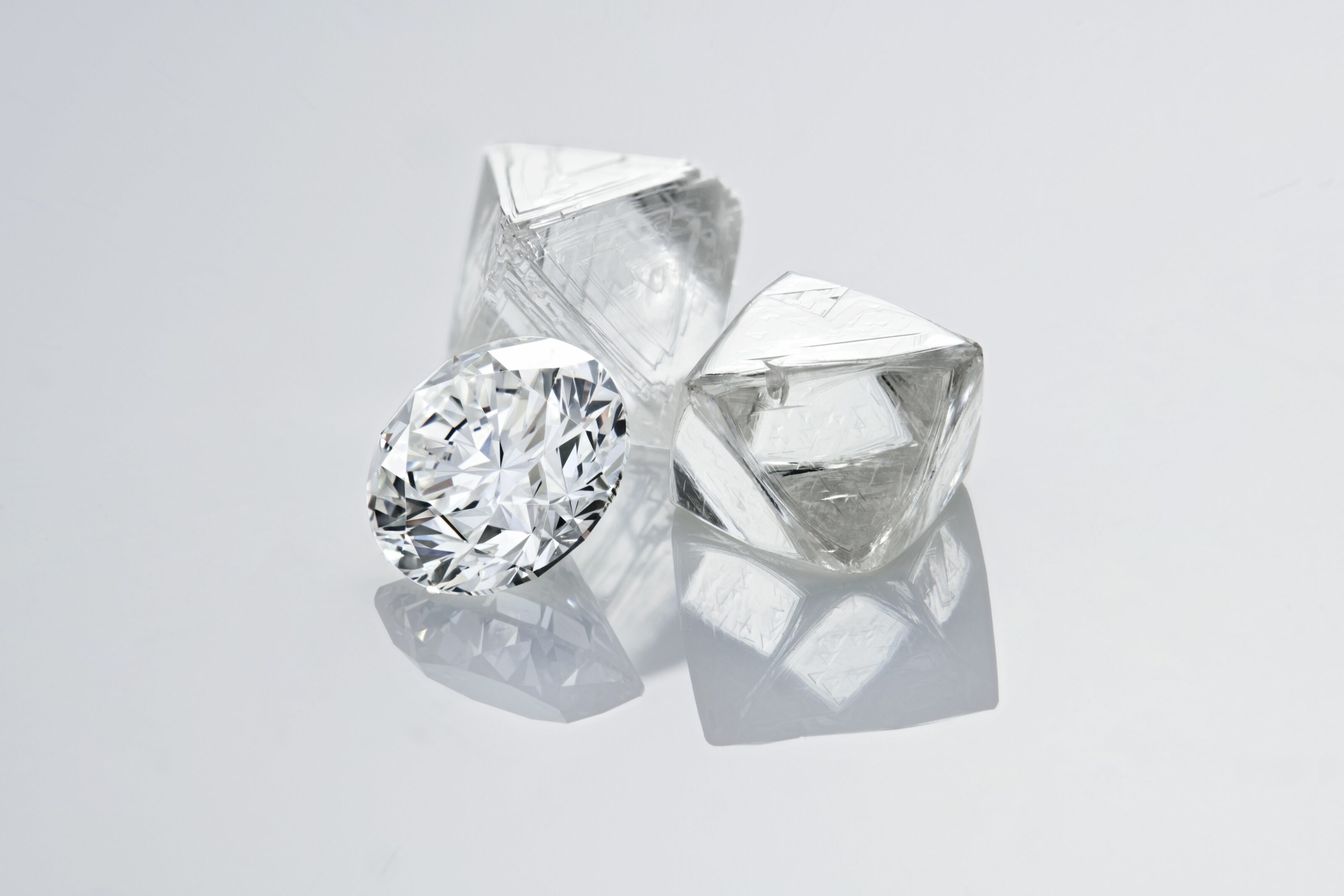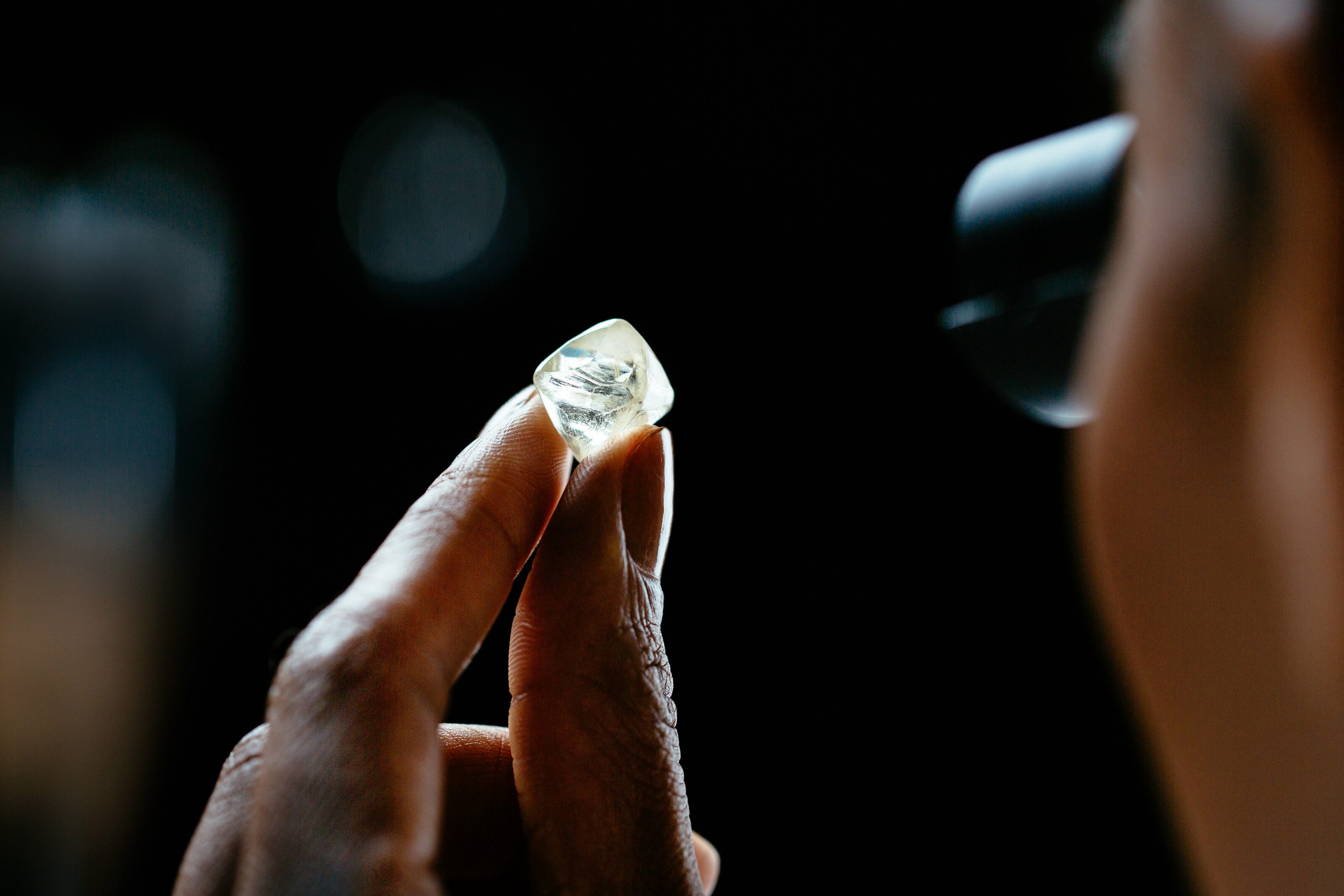The Secrets Trapped in Diamonds
Hidden within the carbon lattice that delivers the brilliance of a diamond’s sparkle lies insights into the history of our planet.
Beyond their great beauty, diamonds are treasured
by scientists for all of the things we can’t see.
Diamonds form when carbon atoms bond almost exclusively with other carbon atoms. More specifically, each carbon atom bonds with four other carbon atoms. Electrostatic forces within and between the bonded carbon atoms lock them into perfectly uniform spacing: Each carbon atom is exactly the same distance from each of the other carbon atoms that it is bonded to. The regular and precise spacing between atoms in three-dimensional space is why diamonds are transparent. It is also why diamonds can be cut to precise angles, forming perfect lines and planes. It’s what gives them their sparkle.
Carbon is one of only a few atoms that can form such perfect, uniform bonds with itself. That’s one of the reasons that diamonds are unique compared to other natural materials. But carbon doesn’t have to bond with itself in the specific way that gives rise to diamonds. In fact, it’s only under very specific conditions – at very high temperatures and pressures – that diamonds will form.

Those conditions were found deep in the Earth, billions of years ago.
At that time, our planet was in its infancy. Its outer surface – the continental and oceanic crust that supports the rich diversity of life that we know today – was still developing from the hot, swirling ball of liquids and gases that constituted Earth at the time. How and when the continents emerged from that bubbly, molten soup is not yet fully understood. Neither is the extent to which Earth’s crust has emerged from its fiery mantle only to be consumed by it at a later time and then rebuilt anew.
One of the challenges in understanding how and when Earth’s crust formed is that it happened so long ago and so far below Earth’s surface: It’s just not possible collect samples from such depths with current technology. Even if we could reach that far into the Earth, how do you collect samples from a billion years ago?
Herein lies the hidden value of diamonds: They are ideal vessels in which ancient messages can be carried forward through time from seemingly un-survivable depths, pressures, and temperatures.
Diamonds carry billion-year-old messages from Earth’s mantle to its surface.
Once formed, diamonds are nearly impossible to transform: They do not generally do things like burn, rust, or dissolve in acids, bases, water, or oil. These properties ensure that the messages diamonds carry are preserved for the duration of their billion-year journey into the hands of the modern-day scientists who are eagerly awaiting the chance to decode them.
The messages carried by diamonds come in several forms. One form is delivered in the carbon atoms themselves.
At the heart of every carbon atom lies a cluster of protons and neutrons around which the atom’s electrons swirl. A typical carbon atom consists of six protons, six electrons, and six neutrons. The number of protons and electrons is relatively fixed, but the number of neutrons can vary. Carbon atoms with different numbers of neutrons are known as isotopes of carbon.
Only three carbon isotopes are found on Earth. Carbon-12 is the most common isotope and accounts for about 99% of the carbon on Earth. Most of the remaining 1% is carbon-13. These two isotopes are stable, meaning that they are unlikely to transform into a different isotope or element over time.
The third isotope of carbon found on Earth, carbon-14, is unstable: over thousands of years it gradually transforms into nitrogen. The instability of carbon-14 allows scientists to determine how old objects are by comparing the ratio of carbon-14 to the other isotopes of carbon present.

Carbon-14 dating is not useful for determining the age of diamonds: it transforms into nitrogen so quickly that it can only be used to determine the age of objects that are up to about 50,000 – 60,000 years old.
Fortunately, isotopes of other atoms transform much more slowly and can be used to age much older objects, including diamonds.
The ratios of carbon-12 to carbon-13 in different features of Earth are fairly predictable and act like “fingerprints” that can provide scientists with information about where or how a geological object or feature originated. For scientists interested in understanding the origin of Earth’s continents, the ratio of carbon-12 and carbon-13 found in diamonds points to the materials from which they formed.
Diamonds also carry other kinds of elemental messages: These messages come in the form of elements that get locked inside diamonds as they form, commonly known as inclusions. Effectively, inclusions are tiny samples of historic conditions that were collected by a diamond when it formed.
Inclusions allow scientists to collect and examine geological samples from billions of years ago.
Inclusions help scientists understand how different elements were distributed on and below Earth’s surface billions of years ago and the extent to which Earth’s crust has been recycled from its surface back into its mantle. Scientists can also use the composition of inclusions to infer the pervading temperature and pressure that existed at the time that the diamond – and the early crust – formed.

Together, the ratios of carbon-12 and carbon-13, the elemental composition of inclusions, and the ratios of other unstable isotopes found in diamonds are decoded to provide crucial insights into how the surface of our planet formed and has transformed over time.
To scientists, the value of a diamond lies in the information it carries about our planet’s history: Embedded in its very structure and sometimes captured inside its virtually immutable form, each diamond carries clues about how our planet developed into the Earth we know today.
Diamonds truly are natural wonders: they are time capsules that allow scientists to collect samples from billions of years ago.
In the same way that diamonds carry hidden messages about our planet, each diamond also carries the signature of its origin and the conditions it experienced as it grew. Its unique story is forever embedded in and discernible from its very elemental structure.
What ancient secrets do your diamonds have to tell?
